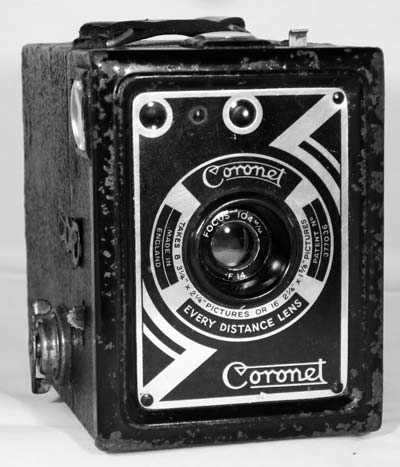Coronet Every Distance 16
Specification

| Manufacturer | : | Coronet |
|---|---|---|
| Produced | : | 1930 |
| Classification | : | Medium Format |
| Body Type | : | Box |
| Construction | : | Metal/Wood |
| Film Type | : | 120 |
| Film Width | : | 62mm |
| Image Size | : | 2¼ x 3¼ in or 2¼ x 1 ⅝ |
| No. of Images | : | 8 or 16 |
| Lens Type | : | Meniscus |
| Focus Type | : | Fixed |
| Focal Length | : | 104mm |
| Focus Range | : | 8ft to inf. |
| Aperture Type | : | Fixed |
| Aperture | : | f/14 |
| Shutter Type | : | Rotary |
| Shutter Speeds | : | B,I*(1/30 sec) |
| Size (w x h x d) | : | 85 x 105 x 120 mm |
| Weight | : | 473g |
| * Measured on this camera | ||
Art Deco Credentials
![]()
![]()
Acceptable: Modest and restricted
- Produced during the main Art Deco period;
- Geometric black and chrome pattern on front plate;
- Bright metal winder.
- Leather strap
Description
The front of this camera has an Art Deco geometric design. The rest of the camera is simply covered in leatherette cloth. It is basically a metal box with the shutter mechanism mounted on a block of wood in the centre of the camera. It has a genuine leather handle. There are no tripod sockets.
It has two bright waist level viewfinders, one for portrait and one for landscape images. It has a simple 'Every Distance' meniscus lens with an aperture of f/14. 'Every Distance' simply means it is fixed focus. The shutter is a double acting rotary, so the shutter button returns to its resting position (upwards) once released, without causing double exposure. A tab on the top of the camera enables you to select Instantaneous or Timed(bulb) mode. The speed of the shutter on this camera was measured as 1/30 sec.
The camera has two red windows. This allows the user to take either 8 2¼ x 3¼ inch exposures or 16 2¼ x 1 ⅝ inch exposures. To take 16 exposures , a mask is fitted to the film plane and both red windows are used. Without the mask just one red window is used. Unfortunately, there is nowhere to store the film mask inside the camera and many of these masks are subsequently lost. Compare this with the Ensign E20 which stores the mask internally. It has an s-shaped knob to wind the film on.
How to Use
This camera takes 120 film which is easily available.
As the shutter speed is only 1/30s, it is advisable to use a tripod to get clear shake free images. However, holding it against a wall or other solid object would work as well. For quick snapshots, hold it firmly against your body.
If you don't want to bother with an exposure meter, follow the guide shown. It is based on the 'Sunny 16' rule. Film is so forgiving and will produce acceptable results even when overexposed by 2 or 3 stops or underexposed by 1 stop.
The tables assume that the sun is at least 30 degrees above the horizon - that's 10am - 5pm on a summers day (May - August) in the UK.
Remember that the exposure guide in the manual may not be helpful as it is based on the use of old film with a low ISO value.
Using ISO 100/125 film - shutter speed 1/30s
| Weather Conditions | Shadow Detail | Aperture | Exposure |
|---|---|---|---|
 Sunny SunnySnow/Sand | Dark with sharp edges | f/14 | +3 Stops Overexposed Acceptable |
 Sunny Sunny | Distinct | f/14 | +2 Stops Overexposed Acceptable |
 Slight Overcast Slight Overcast | Soft around edges | f/14 | +1 Stop Overexposed Acceptable |
 Overcast Overcast | Barely visible | f/14 | Good |
 Heavy Overcast Heavy Overcast | None | f/14 | -1 Stop Underexposed Acceptable |
 Open Shade Open Shade/Sunset | None | f/14 | -2 Stops Underexposed Not Acceptable |